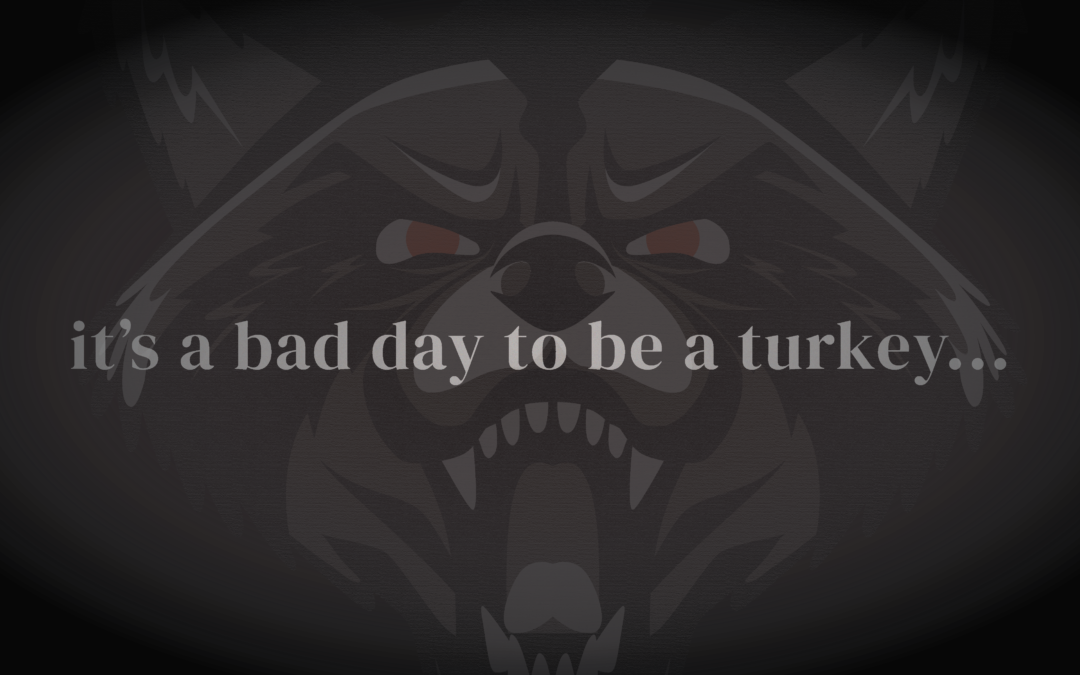(Warning: vivid and true animal fatalities, don’t read if you get spooked too easily!)
As many of you may know, we raise our Joe’s Farm Fresh Turkeys in St. Marys, Ohio with our good farming friends, Ted Kuck and his son, Karl Kuck. It’s a wonderful arrangement, as Ted and Karl raise our turkeys to the highest standards without using GMO feed or antibiotics. Did we mention they’re sustainably raised to Global Animal Welfare Standard level 5 too?
We raise well over 2000 turkeys and any that aren’t sold at Joe’s are sold to the national Whole Foods chain, retailing at $2/lb more because of how much we exceed their standards.
So, how is raising turkeys the subject of a spooky Halloween story? Sit back and read, dear customers—we promise you will never view camping or woodland creatures the same way!
This story takes place 8 years ago, in St. Marys, Ohio. Farmers Ted and Karl own a large plot of land to pasture-raise our turkeys. The land is shaped like a donut, with the hole of the donut holding a 200-acre wooded area that’s brimming with wildlife. The turkeys are pastured around the wooded area in a circular fashion, with several sections fenced off for them to roam.
The first sign that something was very wrong happened mid-July of 2013. It had been an unusually dry, hot summer so keeping the animals hydrated and healthy was a big challenge. One morning, farmer Ted was making his daily rounds through the turkey fields when he found a horrifying sight in the corner of the pasture—a mutilated turkey laying in a pool of its own blood where turkey pasture and wooded area fences met. It’s got to be a coyote or fox, he thought, already calculating in his head what he’d have to submit to the Ohio Department of Agriculture in order to legally trap the killer. As he approached the corpse, he noticed something very odd. The entrails were gone, the turkey’s head was separated from its body and the meat of the turkey was left behind. Uh oh, it must be a sick coyote or fox, he thought, as these carnivores would never leave good meat behind.
Farmer Ted called the state agriculture department and got their permission to set the traps, but before he even had the chance to act, the scene repeated itself the next day. This time the victims were two turkeys in an adjacent field—both in the corner where the two fences met. He concluded something was cornering the turkeys, perhaps something in a pack. It’s coyotes for sure, he thought. Farmer Ted set his perimeter cage traps around the fields and waited patiently.
The next day, farmer Ted found more turkey’s that lie victim to this attack, but no captured assassins in the fields. The day after, he found two more murders and then three more the day after that. At this rate, a serious turkey farm threat was looming. Farmer Karl was forced to call the state agriculture department to have them pay a visit to the farm. What type of creature would eat the guts and leave the good meat behind? The agriculture workers showed up the next day and speculated the killer to be a badger or a wolverine, but neither were normal for this area of Ohio. They had noticed tracks by the dead turkeys, but couldn’t put a finger on what type of creature the perpetrator was, even though they came to the conclusion that it wasn’t a fox or coyote issue. The agriculture department supplied Ted and Karl with battery-operated field cameras that were placed in the corners of the turkey fields in a last chance hope of finding the murderer.
It didn’t take long to crack the case, as the mystery was solved the very next day … sadly a little too late for 45 of our turkey friends.
The villain was a band of wild raccoons who were displaying the adaptive behavior of hunting in packs!
It turns out the dry summer season had deprived the wooded area in the center of the turkey fields of adequate food sources—berries, frogs and crayfish; the normal diet for raccoons. After doing some research, farmer Ted and Karl found out that ancestrally, raccoons are more closely related to bears than other animals, meaning they are omnivores and while they prefer their woodsy diet, if hungry, they will seek out alternatives.
The camera footage showed a pack of three raccoons. Two would chase the turkeys into a corner, where raccoon number three was waiting atop the fence to finish the kill. As raccoon number one and two closed in on the turkeys, raccoon number three would swipe the heads of the turkeys and the other two would charge in, finishing off the dead and gaining a tasty turkey treat.
The Department of Agriculture shared some bad news with Ted and Karl—something sustainable farmers never want the hear. They were instructed to trap and eliminate the killer raccoons. Why eliminate them? Well, raccoons are highly intelligent animals and will teach their peers and young how to eat and hunt. If not eliminated, they could spread to other woods nearby and teach the other raccoons their murderous ways, eventually extending their killer behaviors to neighboring livestock farms, endangering turkeys, chickens and small farm animals such as baby lambs or goats.
Over the course of the next three weeks, the problem was finally solved. Farmer Ted and Karl trapped over 20 raccoons—the three largest all weighed in at over 35lbs each!
So, the next time you are camping with your small children during a dry, hot summer, and a 35lb raccoon approaches your camp…. remember they aren’t the cute little bandits we all think of them to be! Killer raccoons are real and living in a wooded area near you!

